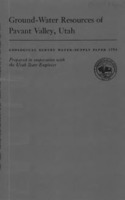Ground-water resources of Pavant Valley, Utah
Links
- Document: Report (pdf)
- Plates:
- Plate 1 (pdf) Map of Pavant Valley, Utah, showing location of selected wells and hydrogeochemical data
- Plate 2 (pdf) Generalized geologic map of Pavant Valley, Utah
- Plate 3 (pdf) Strip logs from drillers' logs of wells in Pavant Valley, Utah
- Plate 4 (pdf) Map of Pavant Valley, Utah, showing ground-water contours, March 1960
- Plate 5 (pdf) Map showing decline of ground-water level from March to September 1960 in Pavant Valley, Utah
- Plate 6 (pdf) Map showing decline of ground-water level from March 1959 to March 1960 in Pavant Valley, Utah
- Plate 7 (pdf) Hydrographs of selected observation wells in Pavant Valley, Utah, 1929-62
- Plate 8 (pdf) Map showing decline of ground-water level from March 1950 to March 1960 in Pavant Valley, Utah
- Plate 9 (pdf) Map showing areas of artesian flow and phreatophyte occupation during 1960 in Pavant Valley, Utah
- Plate 10 (pdf) Map showing land irrigated during 1960 in Pavant Valley, Utah
- Download citation as: RIS | Dublin Core
Abstract
Pavant Valley, in eastern Millard County in west-central Utah, is in the Great Basin section of the Basin and Range province. The area of investigation is 34 miles long from north to south and 9 miles wide from east to west and comprises about 300 square miles. Agriculture, tourist trade, and mining are the principal industries. The population of the valley is about 3,500, of which about half live in Fillmore, the county seat of Millard County.
The climate is semiarid and temperatures are moderate. Average normal annual precipitation in the lowlands is estimated to range from 10 to 14 inches. Precipitation is heaviest during the late winter and spring, January through May. The average monthly temperature at Fillmore ranges from 29°F in January to 76°F in July; the average annual temperature is 52°F.
Because of the aridity, most crops cannot be grown successfully without irrigation. Irrigation requirements were satisfied for about 60 years after the valley was settled by diverting streams tributary to the valley. Artesian water was discovered near Flowell in 1915. By 1920 flowing artesian wells supplied about 10 percent of the irrigation water used in the valley, not including water from the Central Utah Canal. The Central Utah Canal was constructed in 1916 to convey water to the Pavant Valley from the Sevier River. Especially since 1916, the quantity of surface water available each year for irrigation has changed with the vagaries of nature. The total percentage of irrigation water contributed by ground water, on the other hand, gradually increased to about 15 percent in 1945 and then increased rapidly to 45 percent in 1960; it will probably stabilize at about 50 percent.
| Publication type | Report |
|---|---|
| Publication Subtype | USGS Numbered Series |
| Title | Ground-water resources of Pavant Valley, Utah |
| Series title | Water Supply Paper |
| Series number | 1794 |
| DOI | 10.3133/wsp1794 |
| Year Published | 1965 |
| Language | English |
| Publisher | U.S. Government Printing Office |
| Publisher location | Washington, D.C. |
| Contributing office(s) | Utah Water Science Center |
| Description | Report: v, 78 p.; 10 Plates: 36.50 x 39.00 or smaller |
| Country | United States |
| State | Utah |
| County | Millard County |
| Other Geospatial | Pavant Valley |


